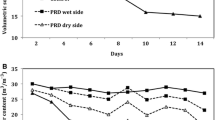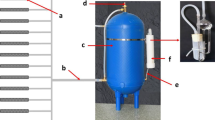Abstract
Partial rootzone drying (PRD) is a water-saving irrigation practice which involves watering only part of the rhizosphere at each irrigation with the complement left to dry to a pre-determined level. The effect of PRD, applied at different phenological stages, on yield, fruit growth, and quality of the processing tomato cv. ‘Petopride’ was studied in this experiment. The treatments were: daily full irrigation (FI) on both sides of the root system considered as the control, and PRD treatments applied at three phenological stages. These were: during the vegetative stage until the first truss was observed (PRDVS–FT), from the first truss to fruit set (PRDFT–FS), and from fruit set to harvest (PRDFS–H). In some occasions, leaf xylem water potential was lower in each PRD period than in FI. Number of fruits, total fresh and dry weight of fruit per plant, harvest index, and fruit growth were lower in PRDFT–FS and PRDFS–H plants than in FI and PRDVS–FT plants. However, irrigation water use efficiency, on a dry weight basis, was the same among the treatments. For PRDFT–FS and PRDFS–H treatments, mean fresh weight of fruit and fruit water content were reduced and dry matter concentration of cortex and total soluble solids concentration of fruit increased compared with FI and PRDVS–FT treatments. Incidence of blossom-end rot was the same among PRDVS–FT, PRDFS–FH, and FI fruit, but it was higher in PRDFT–FS fruit. Fruit skin colour was the same among treatments. Total dry weight of fruit per plant decreased by 23% for PRDFT–FS and by 20% for PRDFS–H relative to FI. Fruit quality improvement in PRDFS–H could compensate for the reduction in total dry weight of fruit where water is expensive for tomato production. But an economical analysis would be needed to substantiate this. PRD from the first truss to fruit set is not recommended because of the high incidence of blossom-end rot.




Similar content being viewed by others
References
Bangerth F (1979) Calcium-related physiological disorders of plants. Ann Rev Phytopathol 17:97–122
Davies WJ, Zhang J (1991) Root signals and the regulation of growth and development of plants in drying soil. Ann Rev Plant Physiol Plant Mol Biol 42:55–76
Davies WJ, Bacon MA, Thompson DS, Sobeih W, González-Rodríguez L (2000) Regulation of leaf and fruit growth in plants growing in drying soil: exploitation of the plants’ chemical signalling system and hydraulic architecture to increase the efficiency of water use in agriculture. J Exp Bot 51:1617–1626
Dry PR, Loveys BR (1999) Grapevine shoot growth and stomatal conductance are reduced when part of the root system is dried. Vitis 38:151–156
Helyes L, Varga G (1994) Irrigation demand of tomato according to the results of three decades. Acta Hortic 376:323–328
Ho LC (1984) Partitioning of assimilates in fruiting tomato plants. Plant Growth Regul 2:277–285
Ho LC (1996) Tomato. In: Zemaski E, Schaffer AA (eds) Photoassimilate distribution in plants and crops: source–sink relationships. Marcel Dekker, New York, pp 709–728
Ho LC (1999) The physiological basis for improving tomato fruit quality. Acta Hortic 487:33–40
Holbrook NM, Shashidhar VR, James RA, Munns R (2002) Stomatal control in tomato with ABA-deficient roots: response of grafted plants to soil drying. J Exp Bot 53:1503–1514
Hsiao TC (1990) Plant–atmosphere interactions, evapotranspiration, and irrigation scheduling. Acta Hort 278:55–66
Kitano M, Yokomakura F, Eguchi H (1996) Interactive dynamics of fruit and stem growth in tomato plants as affected by root water condition. II. Relation with sucrose translocation. Biotronics 25:75–84
Kramer PJ (1983) Water relations of plants. Academic, London
Kramer PJ, Boyer JS (1995) Water relations of plants and soils. Academic, London
Loveys BR, Dry PR, Stoll M, McCarthy MG (2000) Using plant physiology to improve the water use efficiency of horticultural crops. Acta Hortic 537:187–197
Mapelli S, Frova C, Torti G, Sorcessi GP (1978) Relationship between set, development and activities of growth regulators in tomato fruit. Plant Cell Physiol 19:1281–1288
Obreza TA, Pitts DJ, McGovern RJ, Speen TH (1996) Deficit irrigation of micro-irrigated tomato affects yield, fruit quality, and disease severity. J Prod Agric 2:270–275
Parchomchuk P, Tan CS, Berard RG (1997) Practical use of time domain reflectometry for monitoring soil water content in microirrigated orchards. HortTechnology 7:17–22
Postel SL (1998) Water for food production: will there be enough in 2025? Bioscience 48:629–637
Pulupol LU, Behboudian MH, Fisher KJ (1996) Growth, yield and post harvest attributes of glasshouse tomatoes produced under deficit irrigation. HortScience 31:926–929
Saure MC (2001) Blossom-end rot of tomato (Lycopersicon esculentum Mill.)—a calcium—or a stress-related disorder? Sci Hortic 90:193–208
Sobeih WY, Dodd IC, Bacon MA, Grierson D, Davies WJ (2004) Long-distance signals regulating stomatal conductance and leaf growth in tomato (Lycopersicon esculentum) plants subjected to partial root-zone drying. J Exp Bot 55:2353–2363
Steudle E (2000) Water uptake by roots: effects of water deficit. J Exp Bot 51:1531–1542
van Schilfgaarde J (1994) Irrigation—a blessing or a curse. Agric Water Manage 25:203–219
Vartanian N (1981) Some aspects of structural and functional modifications induced by drought in root system. Plant Soil 63:83–92
Young TE, Juvik JA, Sullivan JG (1993) Accumulation of the components of total solids in ripening fruit of tomato. J Am Soc Hort Sci 118:286–292
Zegbe JA, Behboudian MH, Clothier BE (2004) Partial rootzone drying is a feasible option for irrigating processing tomatoes. Agric Water Manage 68:195–206
Zegbe JA, Behboudian MH, Clothier BE (2005) Yield and fruit quality in processing tomato under partial rootzone drying. Eur J Hort Sci (in press)
Acknowledgements
We thank Dr. Tessa Mills and Mr. Ian McIvor, both of HortResearch, for their comments on the manuscript. We thank Hatsue Nakajima, Karma Dorji, and Alma Rosa Rodríguez for their technical assistance. This research was supported in part by the Secretaría de Educación Pública-PROMEP-México, Universidad Autónoma de Zacatecas, and the Instituto Nacional de Investigaciones Forestales, Agrícolas y Pecuarias of México.
Author information
Authors and Affiliations
Corresponding author
Additional information
Communicated by E. Christen
An erratum to this article can be found at http://dx.doi.org/10.1007/s00271-006-0043-y
Rights and permissions
About this article
Cite this article
Zegbe, J.A., Behboudian, M.H. & Clothier, B.E. Responses of ‘Petopride’ processing tomato to partial rootzone drying at different phenological stages. Irrig Sci 24, 203–210 (2006). https://doi.org/10.1007/s00271-005-0018-4
Received:
Accepted:
Published:
Issue Date:
DOI: https://doi.org/10.1007/s00271-005-0018-4




